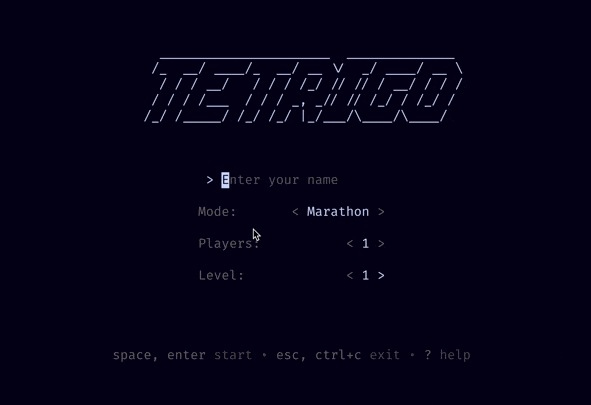teh·tree·go
A Golang implementation of Tetris, following the official 2009 Tetris Design Guideline.
This project consists of three main components, depending on what your goals are:
- "I just want to play Tetris"
- The TUI (Text User Interface) in
cmd/tetrigo/is for you. See the installation section.
- The TUI (Text User Interface) in
- "I want to create my own Tetris game/UI"
- The packages in
pkg/tetris/modes/are for you. You can reuse these game modes with your own UI.
- The packages in
- "I want to create my own Tetris game mode"
- The packages in
pkg/tetris/are for you. You can create your own game mode with a custom set of rules and requirements.
- The packages in
You can find more information on these sections in the development section. If you have a suggestion, bug, or feature request, please open a GitHub issue.
Tetrigo can be installed by downloading the binary or by building from source. See the instructions below for your preferred method.
You can download the binary corresponding to your operating system from the releases page on GitHub.
Once downloaded you can run the binary from the command line:
# Linux or macOS
./tetrigo
# Windows
tetrigo.exeOptionally, you can move the binary to a directory in your $PATH to run it from anywhere (example).
Ensure that you have a supported version of Go properly installed and setup. You can find the minimum required version of Go in the go.mod file.
You can then install the latest release globally by running:
go install github.com/Broderick-Westrope/tetrigo/cmd/tetrigo@latestOr you can install into another directory:
env GOBIN=/bin go install github.com/Broderick-Westrope/tetrigo/cmd/tetrigo@latestFor general information on how to play Tetris see this beginners guide.
The default game controls are as follows:
- Move Left:
A - Move Right:
D - Toggle Soft Drop On/Off:
S - Hard Drop:
W - Rotate Clockwise:
E - Rotate Counter-Clockwise:
Q - Hold Tetrimino / Submit menu option:
SpaceorEnter - Pause Game / Exit:
Escape - Force Quit game:
Ctrl+C - Show Controls Help:
?
The game controls can be changed in the configuration file.
The menu, leaderboard, etc can be navigated using the arrow keys (moving), escape (exit), and enter (submit). These controls are not configurable.
Starting Tetrigo with no subcommand or flags will start the game in the menu where you can manually configure simple settings like the player name and game mode:
./tetrigoYou're also able to start the game directly in a game mode (eg. Marathon), skipping the menu:
# Start the game in Marathon mode with a level of 5 and the player name "Brodie"
./tetrigo play marathon --level=5 --name=Brodie To see more options for starting the game you can run:
./tetrigo --helpMore complex configuration can be done using a TOML file. If no config file is found sensible defaults will be used.
By default, Tetrigo will look for the file ./tetrigo/config.toml within the devices XDG config (or equivalent) directory. The adrg/xdg defines values XDG_CONFIG_HOME for various operating systems (eg. on macOS it is ~/Library/Application Support directory exists it will be stored there, otherwise in ~/Library/Preferences). You can specify a different file using the --config flag.
./tetrigo --config=/path/to/config.tomlAn example configuration file is provided in example.config.toml.
The game data is stored in a SQLite database. By default, the database is stored in ./tetrigo/tetrigo.db within the devices XDG data (or equivalent) directory. The adrg/xdg defines XDG_DATA_HOME for various operating systems (eg. on macOS if the ~/Library/Application Support directory exists it will be stored there, otherwise in /Library/Application Support). You can specify a different file path using the --db flag.
./tetrigo --db=/path/to/data.dbThis project consists of three main components:
cmd/tetrigo/: A TUI (Text User Interface) allowing you to play it out of the box. It also serves as a demonstration on how to use the packages and how to create a TUI using Bubble Tea.pkg/tetris/modes/: The functionality for different Tetris game modes. This can be used to easily create a Tetris game with your own UI but without needing to know the ruleset.pkg/tetris/: The core Tetris logic, including things like Tetrminimos, the Matrix, and scoring. This can be used to create game modes with your own ruleset and requirements.
Task is the build tool used in this project. The Task config lives in Taskfile.yaml. Once the Task CLI is installed, you can see all available tasks by running:
task -lYou can run the TUI using the run task:
task runYou can build the project using the build task:
task buildThis will create a binary in the bin/ directory which can be run using the instructions in the Installation section.
Tests can be run using the test task:
task testYou can also use the cover task to generate and open a coverage report:
task coverThe ordered priorities for testing are:
pkg/tetris/pkg/tetris/modes/cmd/tetrigo/
- Add more tests
- Add tests for scoring endOnMaxLevel.
- Revisit scoring tests.
- Add the remaining Lock Down options.
- Check for Lock Down 0.5s after landing on a surface
- Also on Soft Drop, but not on Hard Drop.
- This resets after each movement & rotation, for a total of 15 movements/rotations.
- See "Extended Placement Lock Down" in the design guidelines.
- Score points from T-Spins
- SSH Multiplayer (akin to Gambit)
